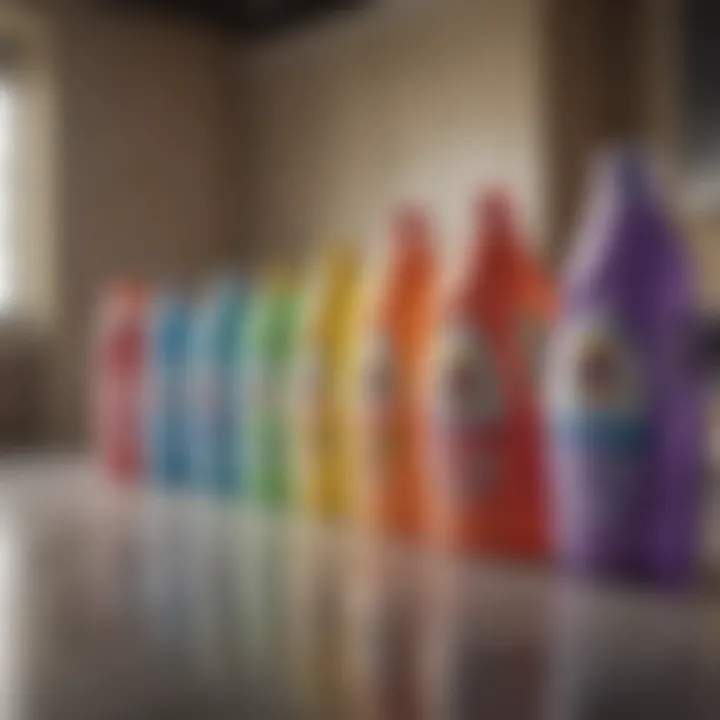Choosing the Best Detergent for Sweaty Clothes


Intro
Choosing the right laundry detergent for clothes that frequently encounter sweat is crucial. As anyone who has dealt with sweaty gym gear or activewear knows, regular soap just doesn't cut it. The lingering odors and ammonia-stained fabrics don't just annoy you, but they can also make you question your laundry habits. With so many options on the market, let’s break down how to pick a detergent that tackles these problems effectively.
Whether you’re a seasoned laundry aficionado or a novice dealing with your household’s sweaty clothes, knowing what to look for can make all the difference.
Current Trends
In the world of laundry care, the trend has shifted towards performance-oriented and eco-friendly options. Consumers increasingly seek products that not only do the job well but also show consideration for the environment.
Eco-friendly Choices
Detergents boasting plant-based ingredients are becoming household staples. Brands like Seventh Generation and Mrs. Meyer's Clean Day have made a significant impact, promoting biodegradable formulas. These options often perform just as well as their chemical counterparts, without the harsh components. They tackle odor and stains from sweat while ensuring you’re not harming the planet.
Favorite Fragrances
In addition to eco-friendliness, fragrance has become a critical consideration. Many consumers prefer fresh, crisp scents that evoke cleanliness. Citrus and floral notes are popular choices, as these scents not only freshen clothes but can also help mask any lingering odors.
Understanding Ingredients
When it comes to selecting the optimal laundry detergent, familiarity with the ingredients can save you a lot of time and trouble. Here are some key components to keep an eye on:
- Enzymes: These natural proteins break down stains and odors efficiently. Protease, amylase, and lipase are common types that target grease, protein, and starch, respectively.
- Surfactants: These compounds reduce surface tension and help the water penetrate into fabrics, lifting dirt and sweat away.
- Fragrance and Dyes: While they may make your laundry smell great, they can also irritate sensitive skin. Opt for fragrance-free options if you have allergies.
Practical Tips for Optimal Usage
Maximize the effectiveness of your chosen detergent with these handy tips:
- Pre-treat Stains: For particularly stubborn marks, apply a small amount of detergent directly to the stain and let it sit for 5-10 minutes before washing.
- Use the Right Amount: More detergent doesn't necessarily mean cleaner clothes. Follow package directions to avoid residue buildup.
- Wash Regularly: The sooner you wash sweaty garments, the less chance odors have to set in. Remember, fresh is best.
"Investing time in pre-treatment and following proper washing techniques can significantly prolong the life of your activewear and enhance its appearance."
Culmination
Selecting a laundry detergent suitable for sweat-stained clothes involves more than just grabbing a bottle off the shelf. By understanding the ingredients, keeping an eye on eco-friendly options, and employing effective laundry practices, you can ensure that your clothes not only come clean but stay fresh longer. A well-informed approach leads to a cleaner wardrobe and a smaller ecological footprint. From gym sessions to weekend sports, rest easy knowing you’re prepared to care for your clothes, the right way.
Understanding the Challenge of Sweaty Clothes
Sweaty garments pose a unique dilemma for many households. The first challenge lies not just in the visible stains, but also in the odors that cling to fabric after physical exertion. Whether it's a brisk jog in the park or a day of hard work around the house, sweat is a natural byproduct of our bodies but nonetheless causes significant frustration when it comes to laundry day. Understanding this challenge is pivotal when selecting the right detergent, as the effectiveness of the chosen product can make or break the cleanliness of your clothes.
Origins of Sweat Odor and Stains
To grasp the best solutions, it’s important to delve into the origins of sweat itself. When we sweat, the body releases a mix of water, salt, and various waste products. While the initial perspiration is relatively odorless, the real trouble begins when bacteria present on our skin feast on the ammonia and fatty acids found in sweat. This interaction produces those telltale odors we all want to avoid. Moreover, these bacteria can cling to fabrics, leading to persistent stains over multiple washes.
In addition, specific fabrics are more prone to retaining these odors. For example, polyester and nylon, often found in athletic wear, are notorious for trapping smells because of their synthetic nature. This understanding should steer consumers toward detergents formulated specifically to target such bacteria, offering a more effective clean.
Common Fabrics and Their Response to Sweat
The type of fabric plays a crucial role in how sweat interacts with clothing. Most people may assume cotton is universally resolute, yet in reality, it too has its challenges. While cotton is breathable and typically allows moisture to evaporate, it can absorb sweat significantly. Once it’s absorbed, that moisture can contribute to staining as it dries. On the other hand, synthetic materials like spandex and certain blends, while designed for comfort and flexibility, can actually hold on to moisture more easily.
Understanding these differences leads one to consider choosing detergents that are specifically formulated not only for odor removal but those that factor in these material-specific characteristics.
- Cotton: Good breathability, but prone to absorbing stains.
- Polyester: Susceptible to holding odors, challenges with moisture wicking.
- Nylon: Durable, yet can retain smells if washed improperly.
- Spandex: Offers stretch but requires careful cleansing to avoid build-up.
Exploring Laundry Detergent Categories
When it comes to tackling sweaty apparel, the type of laundry detergent you choose can make all the difference. In this section, we will take a closer look at various detergent categories, focusing on the critical elements, advantages, and possible downsides of each. This analysis will inform your purchasing decision based on your specific laundry needs and preferences.
Liquid vs. Powder Detergents: An Analysis
Liquid and powder detergents both have their unique strengths. Liquid detergents are often favored for their ability to work effectively in cold water. This is a notable advantage, especially when it comes to saving energy. They dissolve easily in water, making them suitable for pre-treating stains directly on the fabric. Many people find that when dealing with sweat-based stains, liquid formulations can penetrate fabric fibers more effectively, ensuring that odors don’t stick around.
On the other hand, powder detergents tend to be more effective for dealing with particularly tough stains. Their granulated form can help scrub away visible dirt on heavier fabrics. Moreover, powder detergents generally come at a more economical price point.
Here's a brief comparison:
- Liquid Detergents:
- Powder Detergents:


- Pros: Good for cold water, pre-treatments, easy to use
- Cons: Often more expensive, can leave residue in certain conditions
- Pros: Cost-effective, better for tough stains
- Cons: Less effective in cold water, may not dissolve completely if used improperly
With both options on the table, the best choice depends on your laundry routine and preferences. If convenience and ease of use are paramount, liquid might be your go-to. But if frugality and stain-fighting power are what you seek, powder could be the right fit.
Pods and Their Practicality
Laundry pods have gained significant traction in recent years. These pre-measured capsules offer a convenient and mess-free alternative to traditional detergents. Just toss one in, and you’re set. They often contain a combination of liquid detergent, stain removers, and sometimes even fabric softeners. However, while they do simplify the laundry process, not all pods are created equal.
One must consider the concentration. Many pods pack a punch, boasting efficient stain removal, but if you're dealing with particularly heavy sweat stains, they might not always cut it. They also might not dissolve effectively in cold water, leaving residues behind.
Advantages and drawbacks of using pods include:
- Advantages:
- Drawbacks:
- Easy to use: No measuring, no mess
- Compact and convenient for storage
- Consistent results: Pre-measured quantities minimizing overuse
- May not be as effective on stubborn stains
- Higher cost compared to conventional detergents
- Risk of misuse, especially with kids around
In essence, using pods can be a great solution for those who prioritize convenience. However, if you find yourself frequently battling tough odors and stains from sweaty clothes, it might be worth keeping a versatile alternative handy.
"In the world of laundry care, selecting the right detergent is as crucial as choosing the right clothes for your day."
This deeper understanding of the categories of laundry detergents empowers you to make an informed choice that fits your specific laundry needs.
Key Ingredients in Effective Detergents
When it comes to picking a laundry detergent that can tackle the stubborn challenges posed by sweaty apparel, understanding the key ingredients becomes paramount. Different detergents come equipped with a variety of cleaning agents, each one engineered to combat specific issues like odor, stains, and fabric care. Recognizing how these elements work together can steer you toward making an informed decision that aligns better with your washing needs.
Surfactants: The Cleaning Agents
Surfactants, short for surface-active agents, are the true heavyweights in laundry detergents. These compounds have a dual personality; one end is attracted to water, while the other prefers oils and dirt. This unique structure allows surfactants to effectively lift grime away from fabric fibers, making it easier to wash away.
Imagine you're dealing with a workout shirt soaked in sweat and possibly a sprinkle of that post-gym snack—you definitely don’t want that odor lingering. Surfactants swoop in to break down those oils, lifting them off the fabric so they're easily rinsed away in the washing cycle.
However, not all surfactants are created equal. Some may be more effective under certain conditions. For instance, biodegradable surfactants, often found in eco-friendly options, might perform slightly differently than their synthetic counterparts. It's these small differences that can affect the detergent's overall efficacy, especially against sweat stains.
Enzymes: Combatting Protein-Based Stains
Enzymes play a pivotal role, especially when it comes to dealing with tough protein stains, like those found in sweat. These biological catalysts break down specific molecules—proteins, oils, and stains—making removal much easier. Within enzyme-based detergents, there are various types focusing on different stains; proteases deal with protein stains, while amylases are more suited for carbohydrate stains.
Why does this matter? Let’s think about it: you're fresh from an intense workout, and your shirt has turned into a sweat-soaked fabric of odors and grime. If your detergent contains a solid mix of enzymes, it goes straight to work on breaking down those protein compounds that are essentially causing the stink in the first place. The result? A cleaner garment, ready for another round of wear.
Fragrances and Their Role
While practicality dominates the conversation about detergent ingredients, let’s not overlook the allure of fragrances. A good scent can significantly enhance the washing experience, leaving garments smelling fresh rather than echoing the faint remnants of sweat from yesterday's workout.
But here’s the catch—while fragrances are often a selling point, you might want to consider their origin. Some scents derive from natural sources, while others are artificially synthesized. For those with sensitivity or allergies, this can be a deciding factor. Moreover, fragrance-heavy detergents can overshadow residues or stains; therefore, it's crucial to strike a balance between smell and actual cleanliness.
Consumer Preferences and Trends
Understanding consumer preferences and trends is crucial for those looking to choose the best possible laundry detergent for sweat-prone clothing. As customers become more aware of their impact on the environment and their own health, this section explores how these shifts in perspective dictate the product offerings in the market today.
One significant trend is the increasing demand for eco-friendly detergents. Many consumers are eager to minimize their carbon footprint and ensure their cleaning products are biodegradable. This trend isn't just a passing fad; it's an evolution in how people think about their household products. They prefer items that contribute positively to the environment rather than adding to pollution. This preference has prompted many detergent manufacturers to innovate by incorporating plant-based ingredients that are effective yet gentle on the planet.
Another key factor to consider is the rise in popularity of hypoallergenic options. For individuals with sensitive skin or conditions like eczema, selecting a laundry detergent is not merely about cleaning; it involves a careful choice that protects their skin. Hypoallergenic formulations are designed to minimize irritants, making them more appealing to a broader audience, including parents raising babies with delicate skin.
In summary, as the landscape of consumer preferences continues to shift towards sustainable and skin-friendly options, it becomes imperative for individuals to select products that align with these values while effectively tackling the issues of sweat and odor.
"Consumer behavior is often a reflection of broader societal values, influencing everything from product development to marketing strategies."
Popularity of Eco-Friendly Detergents
The surge in popularity of eco-friendly detergents can be pinned down to several different factors. First off, an increasing portion of the population is becoming more conscientious about the ingredients in their products. Many traditional laundry detergents contain harsh chemicals that can be detrimental to the environment, sparking concern among consumers.
Likewise, the impact of plastic waste has caught the attention of eco-aware shoppers. The packaging of eco-friendly detergents is often designed to be more sustainable—be it through recyclable materials or concentrated formulations to reduce packaging size. Consumers appreciate brands that are transparent about their practices and show commitment towards sustainability.


In terms of performance, these eco-friendly options are increasingly matching their conventional counterparts. Brands like Seventh Generation and Ecover have garnered praise for their effectiveness in combating stubborn odors and stains while still remaining gentle on fabrics.
Hypoallergenic Options for Sensitive Skin
For those several the fence about their skin care routine, hypoallergenic laundry detergents have steadily gained traction. A significant proportion of the population experiences skin sensitivity, and using harsh detergents can be a recipe for discomfort.
Hypoallergenic options often avoid common irritants such as dyes and fragrances, addressing consumer concerns head-on. In many cases, these detergents maintain the cleaning power necessary to tackle sweat-induced stains without causing potential harm to the skin.
Families with infants or toddlers often prioritize these gentle options. Parents are keen on what touches their baby's skin, so the use of hypoallergenic detergents becomes a common choice.
Notably, brands like Tide Free & Gentle and All Free Clear stand out because they effectively clean while being gentle on sensitive skin. This balance makes them favorable among parents, those with allergies, and anyone looking to avoid irritation without sacrificing cleanliness.
In summary, while eco-friendly and hypoallergenic options may differ, they both reflect a market that's become more attuned to health, wellness, and environmental concerns. As these trends continue to shape consumer behavior, laundry detergents that balance efficacy with sustainability and gentleness will likely remain a top choice.
Evaluating Top Detergents for Sweat and Odor Removal
When it comes to laundry care, the battle against sweat stains and odors is not just a chore; it's a significant aspect of maintaining the clothes we often wear. Evaluating top detergents tailored specifically for these challenges is paramount in ensuring that garments remain fresh and in good condition. Numerous factors drive this evaluation — effectiveness against particular stains, the formulation of the detergent, and how well it interacts with specific fabrics.
Several elements are paramount when considering the performance of detergents:
- Concentration Levels: The higher the concentration usually means enhanced cleaning power. Some detergents promise to deliver tough stain removal using less product, which can result in cost savings in the long run.
- Stain Removal Technology: Multi-action formulas might include enzymes designed to break down specific components found in sweat, providing a more thorough clean.
- Compatibility with Water Temperature: Not all detergents work best in cold water. Some need hot water to trigger their full potential, which can affect energy usage and fabric care.
In understanding these factors, housewives and homeowners can make more informed choices, leading to cleaner clothes and potentially longer-lasting fabrics. Evaluating these detergents provides insights not just on performance but also on economy and sustainability, which have becoming increasingly important in today’s conscientious marketplace.
Brand and Formulation Comparisons
Each detergent brand carries a claim of superior performance, often backed by targeted formulations. Comparing notable brands is essential for selecting the right product tailored to sweaty apparel. Brands like Tide, Arm & Hammer, and Persil have cemented their reputation based on effectiveness, but it’s crucial to look closely at their specific formulations. Here are some critical comparisons:
- Tide Ultra Stain Release: This detergent is known for its heavy-duty stain fighting capabilities. The combination of advanced enzymes and surfactants supports its effectiveness against oily sweat stains.
- Arm & Hammer Plus OxiClean: Known for leveraging the power of baking soda, this formula emphasizes odor neutralization while also tackling lingering stains vividly. The addition of OxiClean enhances its brightening and cleaning action.
- Persil ProClean: Often touted for its premium cleaning capability, it is formulated to combat tough stains even in cold water, which is suitable for energy-conscious households.
As you look through the offerings on the market, consider not merely the name on the bottle, but the specific ingredients used — that's where the real magic lies.
User Reviews and Effectiveness Analysis
Evaluating the effectiveness of laundry detergents isn’t solely a matter of the marketing claims. User reviews provide valuable insight into the real-world performance of products. From personal experiences reported on platforms like Reddit and Facebook, consumers weigh in on how a detergent stood up against sweat and odor.
Key considerations from user feedback:
- Stain Removal Effectiveness: Many users often rave about how certain detergents not only remove visible stains but also address the smell that develops within the fabrics. Positive reviews frequently highlight products that have distinctly performed well on long-standing stains.
- Skin Sensitivity: For those with sensitive skin, reviews often mention hypoallergenic options as a preferred route. These products promise efficacy without the irritants commonly found in standard detergents, making them suitable for families.
- Value for Money: A recurring theme in user evaluations is whether the product provides tangible value. Many will mention the quantity needed per wash, often sharing tips on best practices for maximizing the use of a given product.
Ultimately, collating user thoughts can challenge preconceived notions about effectiveness and help one make astute choices in the quest for fresher, cleaner laundry.
"Real users can provide insights far beyond any infomercial — their hands-on experience is invaluable for making the right choice in laundry care."
Best Practices for Laundry Care
Laundry isn't merely about tossing dirty clothes into the washing machine. Especially when dealing with sweaty fabrics, understanding best practices can significantly influence the effectiveness of your detergent and the lifespan of your garments. Targeting sweat odors and stains requires a thoughtful approach that considers how different treatment techniques and drying methods can enhance detergent performance.
Pre-Treatment Techniques for Stains
Before diving into the wash, pre-treatment can make a world of difference. Here are some techniques to consider:
- Soaking: For particularly tough stains, soak the fabric in a solution of water and laundry detergent for 30 minutes before washing. This helps the detergent reach the fibers more effectively.
- Stain Removers: Use a specialized stain remover, ideally one formulated for protein-based stains. Apply it directly to the problem area and let it sit for a short while. Being proactive here can prevent permanent staining.
- Dab, Don’t Rub: Always dab the stained area when applying any treatment. Rubbing can push the stain deeper and make it harder to remove.
"An ounce of prevention is worth a pound of cure." – This couldn’t be more true for laundry. Investing time in pre-treatment can save valuable time later during the wash cycle.
Washing and Drying Tips to Enhance Detergent Performance
How you wash and dry your clothes plays a crucial role in how well your detergent works. Here are some key tips:
- The Right Temperature: Always check the care label. Washing sweat-stained garments in the right water temperature (usually hot for cottons and cold for synthetic fabrics) can help break down residue more effectively.
- Don’t Overload the Washer: While it may seem appealing to save time and energy, overcrowding your washing machine can inhibit the detergent from distributing properly. Aim for a load that allows garments to move freely.
- Choose the Right Cycle: For heavily soiled items, use a heavy-duty cycle. Conversely, delicate fabrics often benefit from gentle cycles, ensuring fabric integrity is maintained.
- Drying Method Matters: Air drying can minimize potential fabric damage from the heat of a dryer while also allowing odors to dissipate naturally. If using a dryer, ensure that garments are completely dry before storing them to prevent mustiness.
Each of these laundry care practices enhances the efficacy of the detergent, making sure that clothes come out fresh and clean – a sigh of relief for any householder tackling the challenge of sweaty apparel.
The Role of Fabric Conditioners and Additives
The process of selecting the right laundry detergent is only half the battle when it comes to managing sweaty clothing. The role of fabric conditioners and additives can be crucial in achieving freshness and longevity of your garments. Fabric conditioners serve a dual purpose: they not only enhance the feel of your clothes but can also improve odor management and reduce static cling. Together with the right detergent, they create a synergistic effect that can elevate laundry results.


How Conditioners Work Alongside Detergents
Fabric conditioners are designed to work hand-in-hand with detergents. While detergents focus on breaking down stains and removing dirt, conditioners smooth the fiber of the fabric. This results in less wear and tear during washing. For instance, when washing a sweaty shirt, a strong detergent may tackle the protein stains from perspiration. However, if you incorporate a fabric conditioner during the rinse cycle, it can help to envelop the fibers, making them softer and less prone to damage over multiple washes. Not only does this improve the comfort of wearing the clothing, but it also helps maintain its shape and texture over time.
Additionally, conditioners can enhance the fragrance of clothing. They often contain pleasant scent compounds that can cling to the fabric, giving it that just-laundered freshness that many people adore. However, it’s essential to choose a conditioner that complements your detergent, as some ingredients may not blend well together, causing residues that could affect the overall cleaning performance.
Additives That Target Specific Odors
Certain laundry additives have been specifically developed to tackle tough odors. These additives can be particularly valuable when dealing with sweat. For example, products containing baking soda or activated charcoal can absorb and neutralize unpleasant smells instead of just masking them. These additives work by chemically binding with odor-causing compounds, rendering them ineffective.
Moreover, enzymatic additives can be a game-changer. They target organic materials such as sweat, dirt, and food residues. For instance, protease enzymes break down protein-based odors typical of sweaty clothes, making it easier for the detergent to do its job.
When selecting additives, keep in mind the fabric type. Certain sensitive fabrics may react adversely to heavy-duty additives. Always check the labels or user guides for compatibility with your laundry needs. Also, integrating these additives can be as simple as tossing them in with your usual wash cycle, but careful measurement is crucial, as overdoing it can lead to buildup.
"A good laundry routine isn’t just about detergent; it’s about understanding how to achieve the best results with what you use alongside it."
Uncommon Laundry Solutions
When it comes to tackling the stubborn odors and stains that come from sweaty clothes, exploring uncommon laundry solutions can be a game changer. Many people default to widely known products and methods, often overlooking the more innovative options available. This section presents two significant areas that present alternatives beyond traditional detergents, shedding light on the merits and considerations of each.
Homemade Detergent Alternatives
Creating your own laundry detergent might seem a bit unconventional, but it’s gaining traction among savvy homemakers and eco-conscious individuals. The beauty of homemade detergent is its simplicity and versatility. Often made from basic ingredients that you might already have in your pantry, alternatives like baking soda, vinegar, and Castile soap can clean your clothes without the additional chemicals found in commercial products.
Here’s why many opt for homemade versions:
- Cost-Effective: Making your detergent at home can save you a pretty penny. Bulk-buying ingredients like washing soda or a bar of soap can lower long-term costs significantly.
- Customizable: You can tailor your detergent to suit your specific laundry needs. Got a really sweaty workout shirt? Add some extra vinegar to combat odor. Need something gentler for baby clothes? Skip the harsher ingredients altogether.
- Eco-Friendly: Homemade alternatives tend to have a lower environmental impact. You control the ingredients, steering clear of harmful phosphates and artificial fragrances.
One common recipe includes:
- 1 bar of grated soap (like Fels-Naptha or Castile)
- 1 cup washing soda
- 1 cup borax
Mix it all together, store in an airtight container, and use about 2 tablespoons per load. It not only helps in cleaning but also keeps clothes smelling fresh without complicated chemicals.
Innovative Products in the Market
On the other hand, as consumer preferences shift towards sustainability and efficiency, the market has seen a wave of innovative products specifically designed to handle sweat-related issues in clothing. Companies are increasingly offering specialized detergents formulated with unique ingredients meant to tackle hefty odors effectively. For instance, detergents that use micro-encapsulation technology allow fragrances to be released over time, keeping your clothes smelling great long after washing.
Moreover, some of these innovative products don’t just mask odors. They contain active enzymes that get to the root of the problem, breaking down the proteins that cause sweat stains rather than just washing them away. A few notable examples are:
- OxiClean MaxForce: Known for its aggressive stain-fighting abilities, especially against protein stains from sweat.
- Persil ProClean: Offers outstanding performance in odor removal and stain fighting, making it ideal for athletic wear.
When choosing a new product, consider reading reviews or research on forums like Reddit for real-world feedback. Understanding consumer experiences can give you a clearer perspective on the effectiveness and practicality of these innovative products.
"Choosing the right laundry solution isn’t just about cleaning; it’s about maintaining the quality of your fabrics for years to come."
With a blend of homemade and innovative approaches available, you’re equipped to tackle the relentless challenge of persistent odors and stains in your laundry. Experimenting can lead to satisfying results, helping you find the perfect solution tailored to your needs.
The Ends on Selecting the Best Detergent
Choosing the right laundry detergent is like picking the right tool for a job; if you don’t use the proper one, the results can be less than satisfactory. This article explored the essential aspects of selecting detergents tailored for sweaty apparel, focusing on their ability to tackle sweat stains and odors effectively. The myriad of options available on the market can be daunting, but emphasizing the key elements leads us to better decisions in laundry care.
The primary considerations involve understanding the unique nature of fabrics and the effectiveness of various detergent types against sweat-related issues. Some detergents are specifically formulated with enzymes and surfactants that break down oils and proteins found in sweat, while others focus on masking odors with fragrances. Identifying the right fit for your needs means recognizing these differences and understanding how they interact with your clothing and washing machines.
"One size doesn’t fit all; every fabric tells a different story, and your detergent should resonate with that unique narrative."
Tailoring Choices to Individual Needs
No two households are identical, and the selection of laundry detergent should reflect personal preferences and specific requirements. Factors such as the intensity of workouts, sensitivity to fragrances, or even eco-consciousness can guide choices. For instance, someone practicing rigorous sports may benefit from an enzyme-rich detergent that targets persistent odors and stubborn stains, while another individual with sensitive skin might opt for hypoallergenic products to avoid irritation.
When selecting a detergent, consider:
- Fabric Type: Some fabrics are delicate and can be damaged by harsh chemicals. Always check the label to ensure compatibility.
- Washing Method: Whether using a high-efficiency machine or a conventional one can impact which detergent performs optimally.
- Water Hardness: In areas with hard water, certain detergents may struggle. Choosing one designed to work in tough water conditions could lead to better results.
Paying attention to these factors makes for an efficient laundry system that caters to both garments and the user’s preferences, ensuring each wash and dry cycle delivers a satisfying result.
Final Recommendations Based on Efficacy and Value
After delving through various detergents and their formulations, it becomes apparent that achieving a balance between efficacy and value is essential. Price doesn’t always correlate with performance; many mid-range options effectively combat sweat and odor without breaking the bank. Here are a few recommendations:
- Read Labels: Look for ingredients that target odor elimination or stain removal, especially if sweat is a particular challenge.
- User Reviews: Real-world experiences shared among consumers can provide insight into product performance, especially with specific fabrics or odor problems.
- Trial and Error: Sometimes, it’s about experimenting with different brands and types until you find the one that ticks all boxes for your household needs.
When weighing efficacy against cost, the secret is knowing when to splurge and when to save. Great performance doesn’t always come at a high price, and often those lesser-known brands provide equally good results. Thus, understanding your options equips you with the knowledge to make informed decisions, ensuring your sweaty clothes can be treated with the care they deserve.



